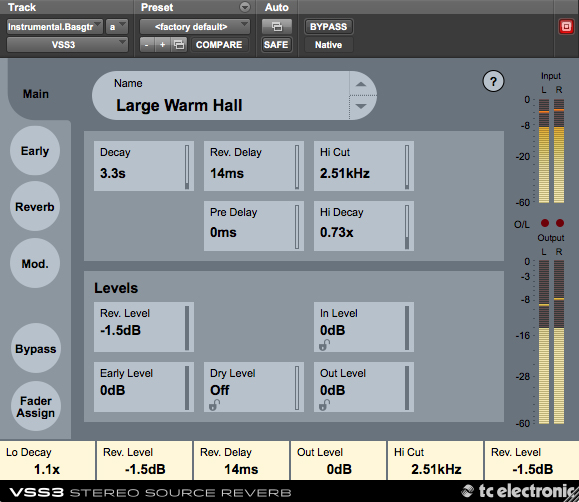|
|
TC Electronic VSS3 Stereo Source Reverb
|
|
|
 |
| TC Electronic VSS3 Stereo Source Reverb |
VSS3 allows for easy customized reverb/ambience construction by offering complete control over the size and reflective patterns of the early reflections coupled with programming the exact nature and tonality of the reverb tail. I always liked what TC calls the Focus Field at the bottom of the compact GUI--it remains resident while cycling through the four main menu pages: Main, Early, Reverb, and Mod.
The Focus field allows for dragging in any of the six parameters you use most; it is stored with the preset and your session. The Main page starts with an up/down scrolling menu of factory presets at its top and continues with parameters for: Decay time (RT60), Rev Delay or the time between the early reflection and the start of reverb, Pre Delay, Hi Cut, and Hi Decay. The bottom half of the Main page window has: Rev, Early Reflection levels and lockable controls for Dry Level, Input and Output levels. You can keep these controls locked while cycling through presets.
A big part of the sound of VSS3 comes from the extensive collection of 24 different Early Reflection types. You'll have: theatres, phone booth, small rooms, car park, airport, even a forest all with a choice of a small, medium, large or fixed Early sizes. You may also adjust the Early Color or high frequency content, the Early Position for either a Close or Distant listening position, and Early Balance for adjusting the left/right balance (pan pot) of the early reflections.
The Reverb page has just the right amount of parameters to dial in your newly designed reverb ambience. The manual suggests that you turn off the early reflection signal to check out Reverb Type changes from Smooth, Natural, Alive, Fast, Alive/Wide and Fast/Wide. Awesome! Rev. Width adjusts the stereo width from "center" panned mono, to stereo or wide or extra wide if you've selected either Alive/Wide or Fast/Wide reverb types.
|
--VSS3 Screens--
Mouse Over To Pause--iPad and Smart Phone Refresh-- |
There are also Lo Cut and Hi Cut filters and Hi Soften--a smoothing effect for the high frequencies. I found this especially useful when building a reverb for a brass section. Hi Soften tones town the brashness of the reverb so I could use more of it without getting excessively brittle sounding.
As a mixing trick, I found Rev Balance great to offset the reverb's diffuse field from the normal center position. I would use two instances of VSS3 each with their Rev Balance set oppositely. Lastly, Diffuse allows for more or less diffusion in the reverb type relative to the decay setting.
The bottom half of the Reverb page has seven controls for Decay/Crossover points that all make significant differences to the final sound of the reverb.
Next the Mod Page has reverb modulations using complex LFO patterns that modulate various parts of the reverb. I have been experimenting with changing these and they affect the synthesized reverb in subtle to extreme ways depending on the reverb ambience you are working with; you'll just have to discover the Mod Page yourself.
There are Smooth 1, Smooth 2, Perc, Wow, Vintage, and Wild RevMod Types and controls for: RevMod Rate, RevMod Width. The lower half of the Mod page has Space Modulation--controls to simulate the air moment in a room--another reason VSS3 does good room simulations. There are controls called: SpcMod Type, SpcMod Rate, SpcMod Width, and SpcMod Depth.
VSS3 finishes with an extensive collection of Factory presets that you can modify and build your own library of User presets. Everything I remember from the TDM version is back in my Pro Tools HDX sessions and I'm starting to incorporate it as part of my mixing template from now on! I highly recommend it!
TC Electronic VSS3 sells for $199 with PowerCore/TDM crossgrade at $99. Nikolaj Willemoes Lund at TC says in the coming months the company will expand the factory presets with signature reverbs designed by Tony Maserati, Mark Christensen and Gordon Williams.Much more at: www.tcelectronic.com/vss3-native/.
|
|
|